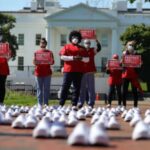“It was 5 in the morning, and my wife and children were still sleeping when I saw three bulldozers coming from a distance on the village’s main road,” said Raed Srour, 45. “When they approached, I could see that they were accompanied by several military jeeps, and I understood that it was an occupation demolition mission on its way to the village. I wondered where they might be headed. It didn’t occur to me that they were coming for my house.”
A father of four, Raed Srour didn’t know that on Monday morning, he and his family had just spent their last night in their home in the village of Ni’lin, west of Ramallah. Srour’s family had been living in that house for seven years after almost ten years of hard work, building it stone by stone.
Elsewhere in the West Bank on that same day, Israeli forces moved to demolish several more Palestinian homes: in Beit Ummar, north of Hebron, a seven-floor residential building was demolished, and in Anata, north of Jerusalem, 14 Palestinian properties received demolition orders. Later in the week, Israeli forces demolished a three-floor residential building in the village of Za’tara east of Bethlehem, in addition to several water wells in Tarqumia, west of Hebron.
The demolition of Palestinian homes is the other side of the coin of Israel’s seizure of Palestinian land for settlement expansion. Since 2023, home demolitions have displaced 7,392 Palestinians.
This demolition blitz has had the effect of clearing vast swathes of the West Bank of Palestinian physical presence, while limiting the urban expansion of Palestinians in their existing places of residence. In the past month alone, Israeli forces demolished 58 Palestinian properties — and 5,900 properties since October 7, 2023.
According to UN Data, in 2023, Israel demolished 1,178 Palestinian properties in the West Bank. That number skyrocketed to 1,768 in 2024, and since the beginning of 2025, Israel has already demolished 627 Palestinian properties.
According to Khalil Tafakji, one of the foremost Palestinian experts on Israeli settlements, “the recent Israeli demolition rampage of Palestinian properties include two types; the demolition of properties in Area C, which are far from the center of towns, and Palestinian buildings at the edges of cities and towns, even if in Area B.”
Areas A, B, and C refer to the Oslo Accords’ delineation of control over land in the West Bank between Israel and the Palestinian Authority. Area C makes up over 60% of the West Bank and falls exclusively under Israeli control. Area A, about 18% of the territory, is controlled by the PA, while the rest of the territory, Area B, falls under joint Israeli-PA control.
“The demolition of farming structures or houses in the heart of rural areas in Area C aims at clearing it of any Palestinian presence,” Tafakji told Mondoweiss, explaining that the demolitions at the edges of villages in Area B have a different purpose. “It aims to cripple the urban growth of Palestinian towns,” he said, adding that it also takes away from the already limited powers of the PA.
In July 2024, the commander of the central region of the West Bank issued a military order allowing the Israeli army to demolish Palestinian properties in some parts of Area B. This is a significant development because it betrays an underlying Israeli policy to limit the physical presence of Palestinians on their land. “In all cases, Israeli demolitions follow one strategic objective, which is to push Palestinians to silently leave the West Bank,” Tafakji notes. “But now it’s happening at an accelerating rate.”
“When a Palestinian family loses a lifetime’s worth of work in a single day and has nowhere else to live, it either moves to the center of towns and cities, or they leave the country altogether at the first chance,” he explained.
This most recent wave of demolitions was preceded earlier this month by statements made by Israel’s Finance Minister, Bezalel Smotrich, saying that “illegal building” on the part of Palestinians had become “a scourge” for Israel. Smotrich’s statements came in the context of his announcement of “a revolution” in settlement expansion in the West Bank that is “unprecedented since 1967.” That same week, the Israeli cabinet approved a large infrastructure project to split the West Bank in two, isolating Palestinian circulation from the east of Jerusalem, where Israel has plans to expand its settlements to reach the Jordan Valley.
“No Homes, No Jobs, No Hope”
In Ni’lin, local journalist Huthaifa Srour tells Mondoweiss that “the homes demolished last week, including that of Raed Srour, are located in Area C. But the majority of the village’s lands are as well, except for the center of the village. Ni’lin families have no place to build new homes except in Area C.”
Ni’lin is located close to the Green Line, which marks the armistice line that delineated the boundaries of the West Bank in 1949. The international community considers it as Israel’s borders.
“Ni’lin as a village is now seen by the Israeli occupation as the new borderline,” Huthaifa Srour explained. “And if these demolitions continue, people in Ni’lin will have no other choice but to build high-rises in the limited space we left, or leave.”
“Building the house cost me and my brother no less than two million shekels, and we are still paying for it,” Raed Srour told Mondoweiss. “I still have to pay 5,000 shekels to the electrician, and the same amount for building material. The windows alone cost 80,000 shekels, and the kitchen cost 70,000. I haven’t even finished paying for them, and now they’re gone,” he lamented.
“My brother and I are construction workers, and we worked very hard inside Israel for years to build a home for both our families,” Srour said. “But now, we lost our home and our work because the occupation revoked all work permits — and there’s no work in the West Bank.”
“We have no homes, no jobs, no hope,” he added.
On the day that Srour’s house was demolished, the Israeli army ordered the family to stand away as the bulldozers went to work. “We watched them tear down the walls and the roof of our house,” Srour recounted. “My wife was weeping and repeating that our lifetime of work had been lost. My children, the youngest of whom is 13, were crying silently. But my brother’s four children, two and five years old, were crying in a panic.”
“They were asking why their house was being destroyed,” he said.
Angry, shocked, overwhelmed? Take action: Support independent media.
We’ve borne witness to a chaotic first few months in Trump’s presidency.
Over the last months, each executive order has delivered shock and bewilderment — a core part of a strategy to make the right-wing turn feel inevitable and overwhelming. But, as organizer Sandra Avalos implored us to remember in Truthout last November, “Together, we are more powerful than Trump.”
Indeed, the Trump administration is pushing through executive orders, but — as we’ve reported at Truthout — many are in legal limbo and face court challenges from unions and civil rights groups. Efforts to quash anti-racist teaching and DEI programs are stalled by education faculty, staff, and students refusing to comply. And communities across the country are coming together to raise the alarm on ICE raids, inform neighbors of their civil rights, and protect each other in moving shows of solidarity.
It will be a long fight ahead. And as nonprofit movement media, Truthout plans to be there documenting and uplifting resistance.
As we undertake this life-sustaining work, we appeal for your support. Please, if you find value in what we do, join our community of sustainers by making a monthly or one-time gift.
Read full article at source
Stay informed about this story by subscribing to our regular Newsletter


